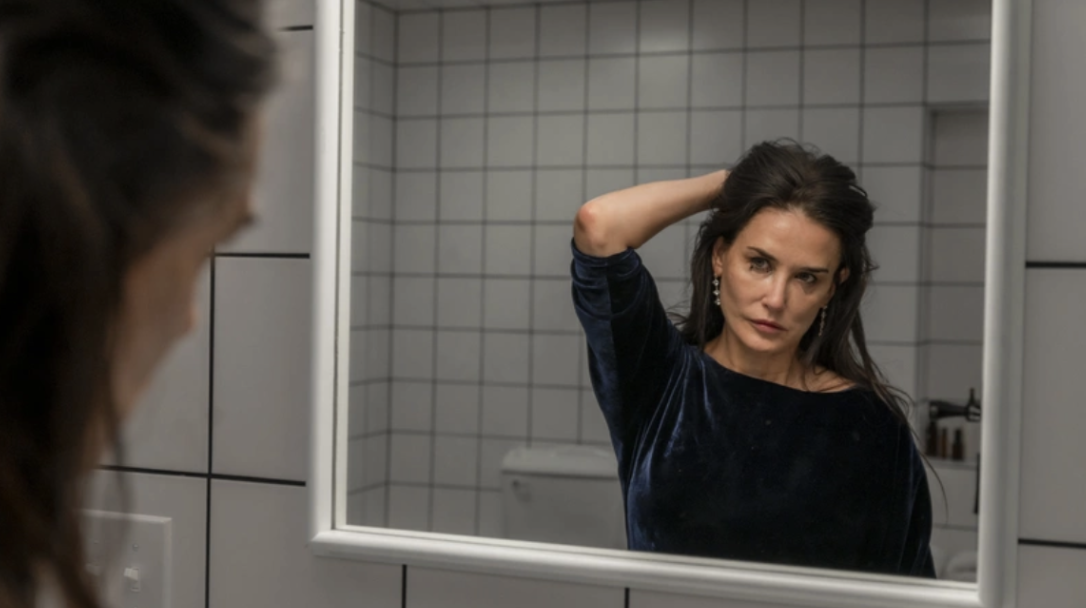Pretty Girls Should Always Smile: “The Substance” is the Body-Horror Film of the Ozempic Era
Image Courtesy: MUBI
“The Substance” is not your mother’s body-horror film. The sophomore effort from French director Coralie Fargeat has gone viral after hitting theatres with a bang, fresh from Cannes (where it reportedly prompted several viewers to walk out and ultimately won the Prix du scénario). With Demi Moore at its center (almost four decades since her star turn in 1985 “St. Elmo’s Fire”) and Margaret Qualley supporting, the matrix of horror in Fargeat’s film is the woman’s body. “The Substance” has been hailed by some as “brilliant” and “scathing,” by others “vapid” and “unsubtle”—all the more reason to see this year’s most disturbing film on the biggest screen you can find.
The opening sequence of “The Substance” where Elisabeth Sparkle’s (Moore) Hollywood Walk-of-Fame Star is weathered over time largely encapsulates the central conceit of this film: over time as a woman ages and her body is deemed less commodifiable by the men around her, she is left alone by said men with mere memories of her past self. Elisabeth experiences this firsthand after being laid off by the misogynist network executive (Dennis Quaid) from her daytime fitness show, “Sparkle Your Life!” on her 50th birthday. She soon after, by chance, finds herself in possession of a dubious flash-drive detailing the titular black market injection that will “release a better version” of herself. There’s a catch though—and there always is—Elisabeth and Sue (her “better version”) must alternate weeks of lucidity, with disastrous consequences for the unlucky soul that “disrespects the balance.” And as Elisabeth wastes away in her apartment staring at the comically large portrait of her younger self while Sue shoots the cover of Vogue, one cannot help but wonder: is there such a thing as “proper use of the substance?” How could anybody stare at a billboard of the reason for their self-hatred—literally, the physical manifestation of what they “should be”—and not want more than a measly week?
Perhaps the most indelible scene (and the one where Moore’s acting chops are most on fearless display) sees Elisabeth preparing for a date with a former high school classmate who thinks she “still is the most beautiful girl in the whole wide world,” only for her to wipe off her makeup in frustration at the inescapable presence of Sue. Although one might instinctively feel some sympathy for the man she stands up to, it’s impossible to forget this classmate’s perception of Elisabeth is still forever haunted by the image of her young self and, therefore, only furthers her view of herself as worthless in age. Fargeat’s anger at the men responsible for Elisabeth’s self-image issues compounds across the runtime (as does the gore) before reaching monstrous heights in the final twenty minutes. All in all, “The Substance” is a film that needs to be seen to be believed.
Image Courtesy: @TryTheSubstance on X
It seems like “The Substance” has arrived at just the right time. Elisabeth Sparkle is every face we see on the silver screen—at what phase in life is irrelevant. In 2024, the injectable Substance taking our world by storm is found not in a dubious locker but over the counter for type 2 diabetes treatment. Demi Moore does not merely bring her role to life or simply embody Elisabeth Rather, she is the famed actress discarded by the entertainment industry’s impossible standard in favor of another younger ingénue (a deliberate casting decision by Fargeat in knowledge of Moore’s career trajectory). The horror of “The Substance” is not just in the scenes of a clone stepping out of the vulvic (just one instance of Fargeat’s masterful visual symbolism) opening in Elisabeth’s spine—it is the realization, permeating the screen and entering the viewers’ psyche, that the deterioration of our own bodies is inevitable. In the Ozempic era, where self-worth is the worth of our bodies as a commodity, everybody is Sue and everybody is Elisabeth Sparkle.
If the sheer spectacle described in Fargeat’s movie has not been enough to convince you to watch “The Substance,” then the self-reflection it provides should be. Love it or hate it, you will have to take a deep breath after!
Strike out,
Santiago Ralston
University of Notre Dame


